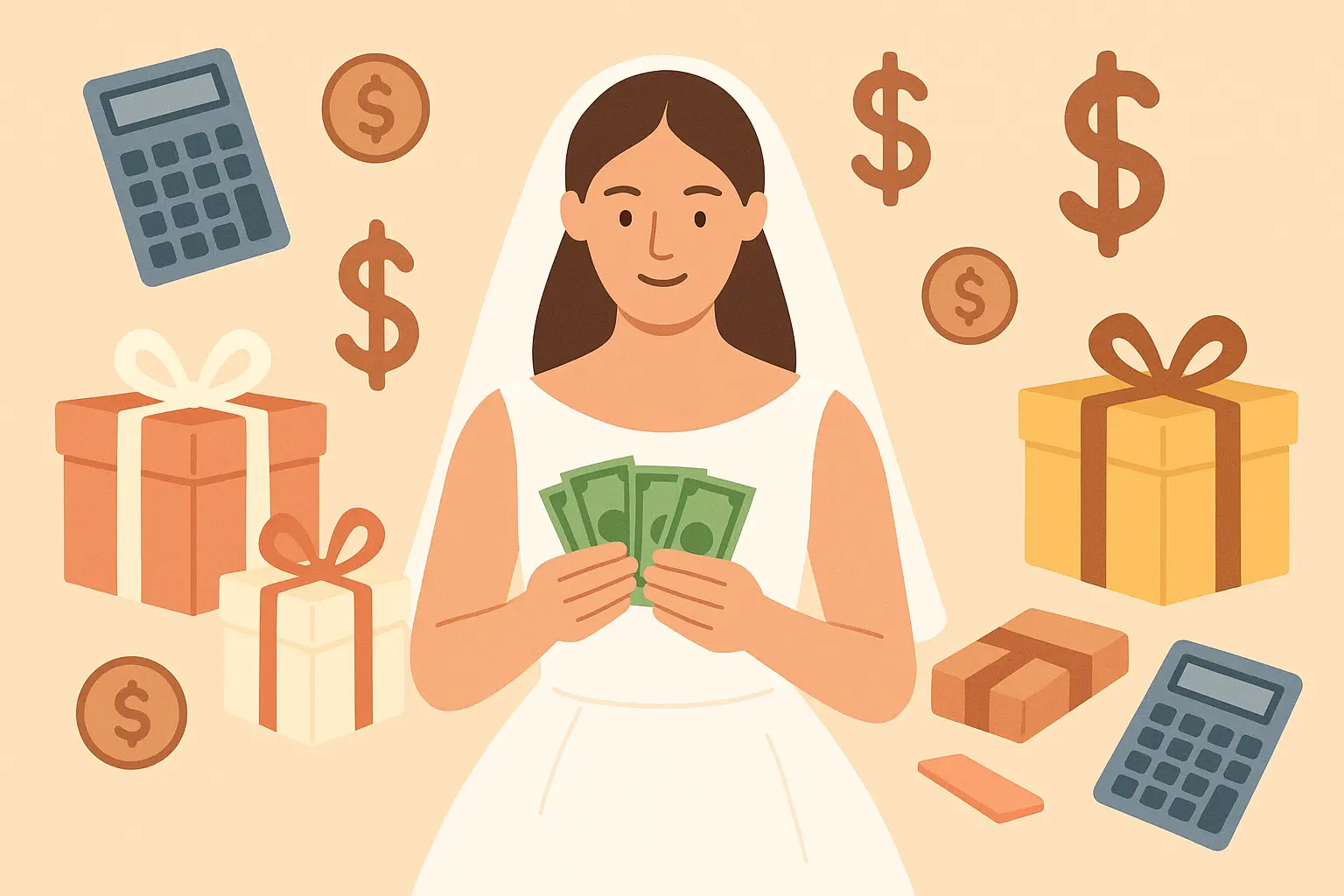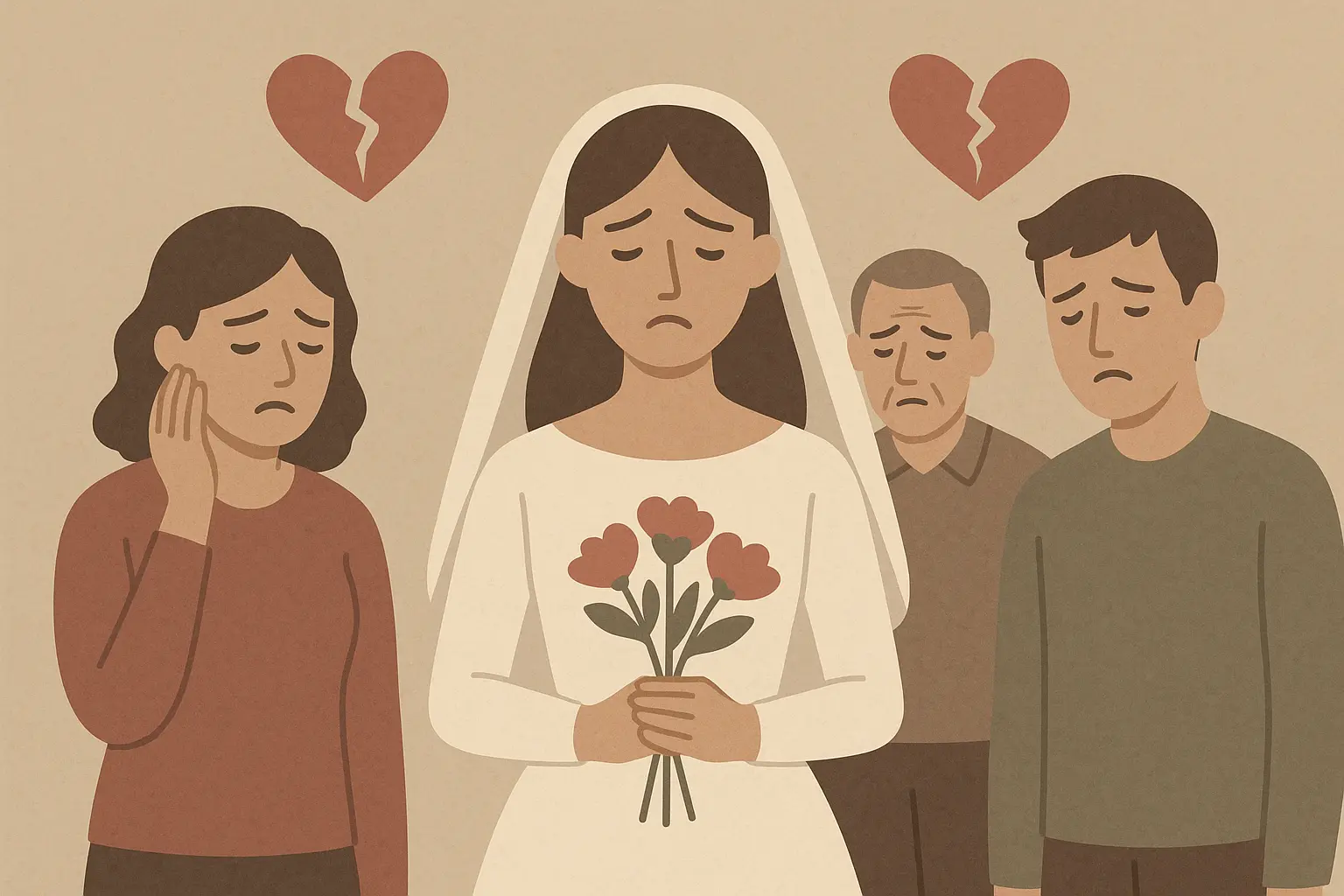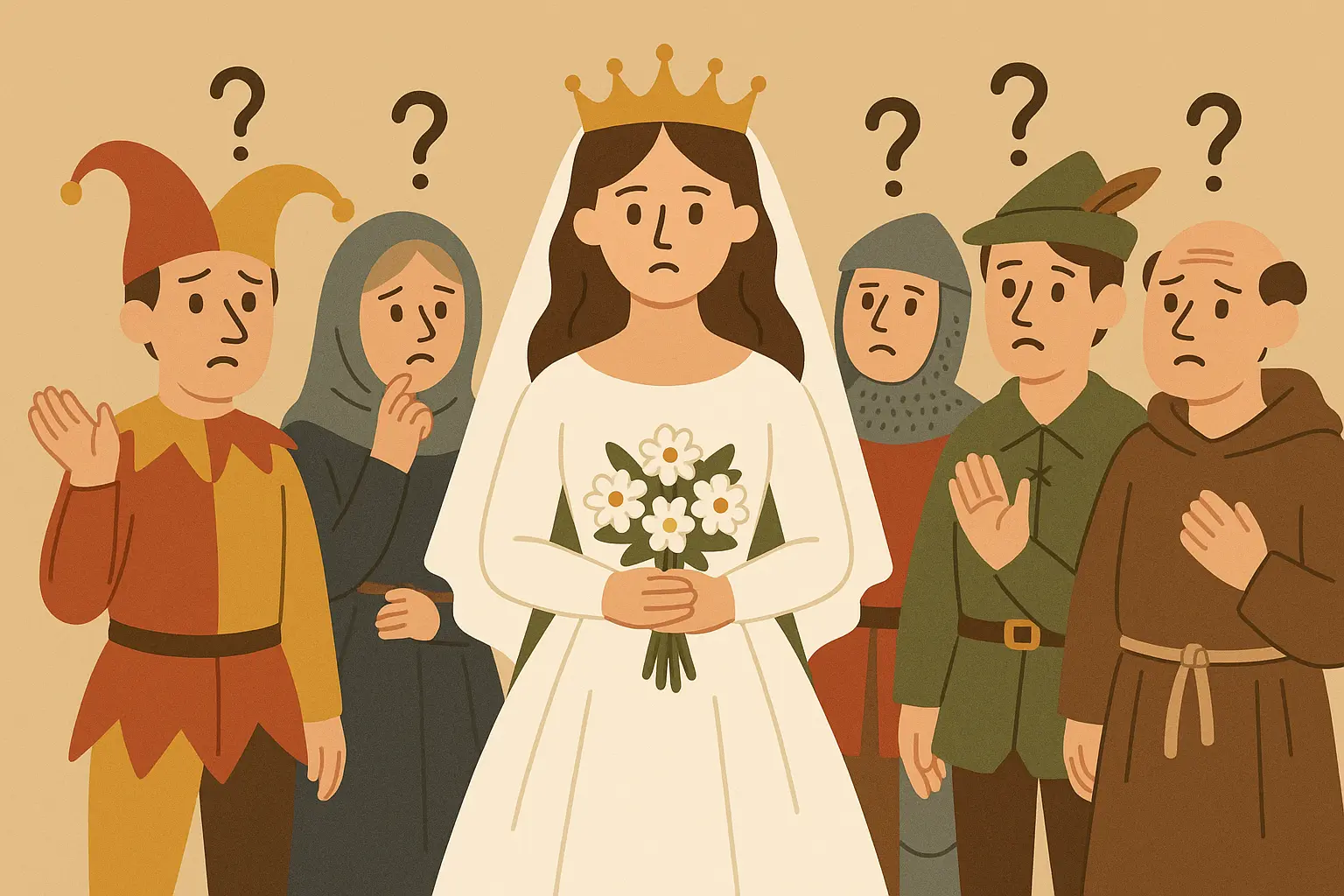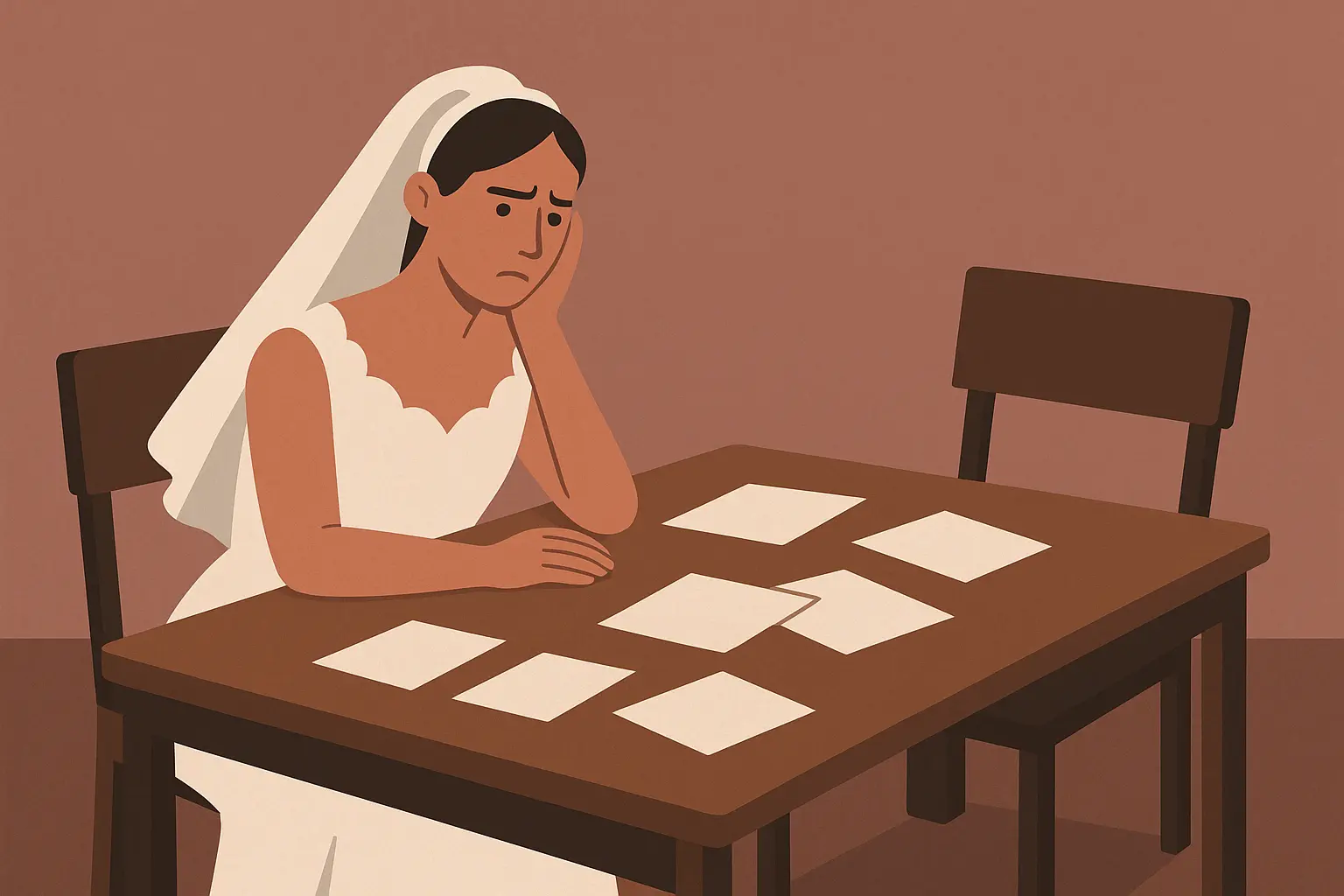Look, we’ve all heard about bridezillas, but some of these stories will absolutely blow your mind. I thought my cousin asking us to dye our hair the same shade of brown was bad – turns out that was just the tip of the iceberg. According to Bored Panda’s research on bridesmaid experiences, wedding planning ranks as one of the most stressful jobs in the world, just after soldiers and firefighters. After digging into countless wedding horror stories, I realized how quickly wedding planning can turn someone you love into someone you barely recognize.
Table of Contents
-
What Makes a Bridezilla Story Worth Sharing
-
How to Spot the Warning Signs Early
-
Money Games & Greed Stories (Stories 1-5)
-
Control Freaks Gone Wild (Stories 6-10)
-
Family & Friend Drama Disasters (Stories 11-14)
-
The Most Ridiculous Demands Ever (Stories 15-18)
-
Vendor Nightmare Stories (Stories 19-22)
-
Post-Wedding Chaos Chronicles (Stories 23-25)
-
Why These Stories Actually Matter
-
Turning Real Drama into Creative Content with Nairrate
TL;DR
-
Bridezilla behavior usually starts with wedding stress but quickly spirals into financial manipulation, emotional abuse, and destroyed relationships
-
The worst stories involve brides who care more about their “perfect day” than basic human decency
-
Some bridesmaids are being asked to spend thousands of dollars per wedding – and that’s not okay
-
Social media and perfectionism have made bridezilla behavior way worse than it used to be
-
These bridezilla stories are entertaining, but they’re also pretty good warning signs about toxic behavior
-
The aftermath usually includes ruined friendships, family feuds, and marriages that don’t last
-
These real-world dramas are goldmines for writers looking to explore human psychology and social dynamics
What Makes a Bridezilla Story Worth Sharing
Here’s the thing about real bridezilla stories – they’re not just gossip or made-up drama. The ones that really stick with you have specific details that make you go “wait, that actually happened?” We’re talking exact dollar amounts, word-for-word conversations, and consequences that you can actually verify.
The best bridezilla stories also show you exactly how things went from zero to crazy. They start with what seems like a reasonable request – maybe asking bridesmaids to wear a certain color – then gradually escalate until you’re reading about brides demanding their friends get abortions to avoid “ruining” wedding photos. Yeah, that’s a real story we’ll get to.

What Makes Wedding Drama Actually Memorable
Good bridezilla stories help you spot red flags in your own life while being entertaining enough that you actually want to read them. It’s like learning about toxic behavior patterns through someone else’s disaster, which honestly beats learning the hard way. Understanding what makes these stories compelling can help writers create better content – kind of like exploring powerful anecdote examples that transform storytelling through real personal experiences.
We’re not talking about vague complaints like “she was difficult.” Bridezilla behavior means concrete evidence of completely unreasonable demands. Think brides requiring their wedding party to spend $3,000 each, or uninviting family members over tiny disagreements. These aren’t personality clashes – they’re documented cases of financial manipulation and emotional abuse.
Why the Entertainment Factor Actually Matters
The stories that really stick with you balance the “no way that happened” factor with emotions you can actually relate to. They’re shocking without being mean-spirited, so you can learn something while still finding them compelling. The best bridezilla tales make you feel multiple things at once – shock at the bride’s behavior, sympathy for everyone else involved, and sometimes dark humor at just how absurd the situation got.
This emotional roller coaster keeps you reading while teaching you important stuff about setting boundaries and recognizing toxic behavior. When a bridezilla demands her pregnant friend get an abortion to avoid “ruining” wedding photos, you’re seeing behavior so extreme it becomes educational about spotting toxic patterns in your own life.
How to Spot the Warning Signs Early
Normal brides might ask for help with wedding costs or suggest bridesmaid dress styles. Bridezilla personalities? They demand mandatory financial contributions, create expensive requirements without caring about anyone’s budget, and use guilt trips or threats to get their way.
Watch out for brides who treat their wedding party like personal ATMs, expecting unlimited financial support for increasingly ridiculous expenses. This worst bridezilla behavior often starts with reasonable requests and escalates to straight-up financial manipulation.
Here’s what normal looks like versus total bridezilla territory:
Normal bride: “Hey, would navy dresses work for everyone? Here are some options at different price points.”
Bridezilla: “You MUST buy this exact $400 dress from this designer, and if you can’t afford it, you obviously don’t care about my wedding.”
Normal bride: “I’m feeling really stressed about all the wedding planning.”
Bridezilla: “My wedding stress means everyone has to do exactly what I say with no questions asked.”
Normal bride: “I’d love some special treatment on my wedding day.”
Bridezilla: “Everyone needs to cater to my every whim for the next six months.”
The Money Red Flags
Bridezilla behavior turns normal coordination into financial blackmail. These brides don’t just suggest – they demand, threaten, and manipulate. They’ll tell bridesmaids that refusing to spend $800 on a dress means they’re “bad friends” or “don’t support the marriage.”
I’ve seen brides use phrases like “If you really cared about me…” or “A real friend would…” to guilt people into spending money they don’t have. They turn minor preferences into major relationship tests, making their wedding a measure of everyone else’s loyalty and love.
Control Freak Warning Signs
Healthy wedding planning involves working together and considering everyone’s needs and limitations. Bridezilla behavior? That’s creating elaborate rules for how guests should look, demanding complete control over everyone’s schedules, and using emotional manipulation to get their way.
These control tactics often start weeks or months before the wedding, with bridezilla personalities trying to dictate their wedding party’s entire lives. The key warning sign is when requests become demands backed by threats or emotional punishment.

Money Games & Greed Stories
1. The Venmo Demand Bride
So get this – Sarah actually Venmo-requested every single wedding guest for $200. Yeah, you read that right. She called it a “mandatory contribution” to cover their “privilege” of attending her destination wedding.
When people questioned this completely insane demand, Sarah’s bridezilla response showed just how entitled she’d become. She said anyone who couldn’t afford the contribution “wasn’t a real friend” and proceeded to uninvite 30 people via group text. This is bridezilla behavior at its worst – turning what should be a celebration into a financial burden with social punishment if you can’t pay up.
2. The Registry Replacer
Jessica’s gift scheme was next-level calculated. After getting a $50 blender as a wedding gift, she returned it and then had the audacity to demand the gift-giver send her the $300 cash difference to “upgrade to something actually useful.”
But wait, it gets worse. She created a spreadsheet tracking all gifts and their “inadequate” values, treating wedding presents like business transactions instead of expressions of love from friends and family. This bridezilla behavior turns the joy of gift-giving into a cold transaction where presents are judged purely on price tags rather than thoughtfulness or what people can actually afford.
3. The Bridesmaid Bankruptcy
Amanda’s bridesmaid requirements were absolutely insane. She required her bridesmaids to buy $800 dresses, $200 shoes, $300 professional hair and makeup, throw a $2000 bachelorette party, AND buy wedding shower gifts.
When one bridesmaid couldn’t afford this complete financial package (because hello, that’s over $3000 per person), Amanda’s bridezilla response was to publicly shame her on social media. She prioritized her wedding vision over a meaningful friendship. These entitled bridezilla stories show how wedding planning can become straight-up financial exploitation, where brides treat their friends as funding sources instead of loved ones celebrating their marriage.
Let me break down just how ridiculous these costs were:
-
Bridesmaid Dress: Normal cost $100-200, Amanda demanded $800+ (that’s 4x normal!)
-
Shoes: Normal cost $50-80, she wanted $200+ (3x normal!)
-
Hair & Makeup: Normal cost $100-150, her requirement was $300+ (double!)
-
Bachelorette Party: Normal cost $200-400 per person, hers was $500+ per person
-
Shower Gifts: Normal range $50-100, she expected $200+
4. The Cash Bar Scandal
Monica’s cash bar scheme was straight-up theft disguised as wedding planning. Despite having a cash bar at her reception, she kept all the money guests spent on drinks, claiming it was “additional wedding gifts” rather than payment for beverages.
She made nearly $3000 from this shady practice and actually bragged about her “clever money-making scheme” to others. I’m sorry, what? This story shows how bridezilla behavior can cross from being socially rude into potentially criminal territory, since guests paid for drinks thinking they were buying them, not gifting them.
5. The Gift Return Grifter
Kelly’s fraud scheme was premeditated and absolutely shameless. She returned every single wedding gift for cash, then told the original gift-givers that their presents had been “stolen” and asked for replacement gifts.
Her systematic approach netted over $5000 before a suspicious cousin exposed the whole thing. This wasn’t impulsive bridezilla behavior – this was deliberate fraud using her wedding as cover. The story shows how wedding gift expectations can be exploited for straight-up criminal behavior, turning what should be a celebration of love into an opportunity for theft.

Control Freaks Gone Wild
6. The Appearance Police
Christina’s control over her wedding guests reached absolutely dystopian levels with her 47-page document detailing exactly how everyone should look. The document specified acceptable hair colors, makeup styles, and even clothing brands that guests were allowed to wear.
Her enforcement strategy? She hired “appearance monitors” to patrol the wedding and make sure everyone followed her insane rules. This level of bridezilla control turned her wedding from a celebration into a surveillance operation. The story shows how normal preferences about wedding aesthetics can spiral into full-blown authoritarian control when brides completely lose perspective.
7. The Social Media Dictator
Rebecca’s approach to wedding privacy crossed into legal territory with contracts forbidding any social media posts about her wedding. She hired someone to monitor all guests’ social media accounts for 30 days after the wedding, treating friends and family like potential security threats.
When a bridesmaid posted an innocent Instagram story, Rebecca threatened legal action. This worst bridezilla behavior shows how modern technology can extend control way beyond the actual wedding day.
Here’s what normal looks like versus bridezilla territory:
-
Normal approach: “We’d prefer an unplugged ceremony, so please put phones away during the vows.”
-
Bridezilla approach: “Sign this legal contract promising no photos, or you’re uninvited. I’m hiring someone to stalk your social media for a month.”
The psychological complexity in these control scenarios creates the kind of narrative depth you see in story theme examples that explore power dynamics and character development.
8. The Schedule Tyrant
Megan’s control extended to every minute of her bridesmaids’ lives during wedding week. She created detailed schedules covering mandatory 5 AM workouts, specific meal times, and required bedtimes, treating her friends like employees instead of loved ones.
But here’s the kicker – she used GPS tracking to monitor their locations. This crosses into straight-up surveillance territory, showing how wedding planning can become a vehicle for psychological control and serious boundary violations. The story demonstrates how legitimate coordination needs can escalate into oppressive micromanagement that treats wedding party members like property instead of people.
Look, bridezilla personalities often justify this level of control by saying they’re “just stressed” or “want everything perfect.” But tracking people’s locations and dictating their sleep schedules goes way beyond normal wedding coordination into controlling behavior that would be unacceptable in literally any other context.
9. The Plus-One Prosecutor
Jennifer’s last-minute plus-one reversal was poor planning disguised as budget consciousness. After initially approving plus-ones for her wedding, she changed her mind just two weeks before the event, uninviting all partners and claiming budget issues.
When guests protested this sudden change that messed up their own planning and relationships, she escalated by threatening to uninvite them entirely, using their attendance as leverage to enforce her new rules. This bridezilla behavior shows how poor wedding planning creates cascading problems that brides then try to solve through manipulation and threats instead of honest communication and compromise.
10. The Vendor Terrorizer
Lisa’s treatment of wedding vendors revealed how bridezilla behavior affects innocent service providers just trying to do their jobs. She fired and publicly trashed five different vendors on social media for minor issues, including a florist who used “the wrong shade of ivory.”
Her public attacks on small businesses showed how bridezilla behavior can have real economic consequences beyond personal relationships, potentially damaging vendors’ reputations and livelihoods over completely trivial concerns. Bridezilla personalities often view vendors as servants instead of professionals, expecting unlimited revisions and perfect execution while showing zero understanding of the realities of event planning and creative services.

Family & Friend Drama Disasters
11. The Sister Saboteur
Rachel’s jealousy over her sister’s engagement turned into active sabotage that damaged their entire family. Claiming she “deserved to go first” as the older sister, she scheduled her own wedding for the same weekend as her sister’s long-planned celebration.
Her competitive bridezilla behavior escalated to stealing vendors and trying to book the same venue, turning what should have been a joyful family milestone into a destructive rivalry. This story shows how sibling dynamics can poison wedding planning, with competitive behavior that prioritizes being “first” over family harmony and actually supporting each other.
12. The Friendship Ender
I wish I was making this up, but Nicole’s response to her best friend’s pregnancy announcement represents the most extreme form of bridezilla selfishness I’ve ever heard. She demanded her friend get an abortion because being pregnant would “ruin the wedding photos.”
When her friend (obviously) refused this completely outrageous demand, Nicole uninvited her and ended their 15-year friendship. This shows how wedding obsession can completely override basic human decency and compassion. These bridezilla stories highlight the most extreme examples of wedding-related cruelty, revealing someone’s true character in the worst possible way.
13. The Mother-in-Law Meltdown
Stephanie’s reaction to her future mother-in-law’s dress choice escalated a minor concern into a family feud that lasted years. Deciding the dress was “too fancy,” she had security escort her new mother-in-law out of the reception and banned her from all wedding photos.
This extreme bridezilla response to a perceived slight created permanent damage to family relationships, showing how wedding day drama can poison the very relationships that should be strengthened by marriage. The story shows how minor wedding day issues can be blown completely out of proportion when brides lose all perspective on what actually matters for their future family harmony.
14. The Attention Thief
Ashley’s response to her cousin’s father’s cancer diagnosis revealed a shocking lack of empathy and perspective. She demanded the family not discuss the illness at her wedding because it would “steal her thunder,” threatening to cancel if anyone mentioned this serious family crisis.
Her inability to show compassion for a family member facing a life-threatening illness showed how wedding obsession can completely override basic human decency and family loyalty. This story represents the extreme end of attention-seeking bridezilla behavior, where a bride’s need to be the center of attention becomes more important than supporting family members through genuine crises.

The Most Ridiculous Demands Ever
15. The Weather Controller
Samantha’s approach to outdoor wedding planning combined magical thinking with legal threats in ways that completely defied logic. Convinced her ceremony would be ruined by rain, she demanded her wedding party perform a “rain dance” ritual to ensure perfect weather.
When it drizzled on her wedding day, she threatened to sue the weather service for their “inaccurate” forecast. I’m sorry, what? This story provides some comic relief while showing how wedding anxiety can turn into completely irrational bridezilla behavior that ignores basic reality. Like, you can’t control the weather, Karen!
16. The Pet Prioritizer
Julie’s wedding priorities created a weird hierarchy where her dog got more attention and money than her new husband. She spent $15,000 on her pet’s wedding outfit and demanded all guests bring gifts specifically for her dog.
Her decision to hire a professional pet photographer and give more ceremony time to her dog than her groom revealed some seriously misplaced values. While eccentric, this stayed relatively harmless compared to other bridezilla behaviors. The story shows how wedding themes and personal interests can be taken to extremes that create unusual guest expectations, though without the malicious intent we see in other bridezilla tales.
17. The Perfection Pursuer
Kimberly’s obsession with Instagram-worthy moments created exhausting demands for everyone involved. She made her wedding party retake photos 47 times and held up the ceremony for two hours to fix a minor makeup smudge.
But wait, it gets worse. She demanded guests re-enter the venue because their initial entrance “wasn’t enthusiastic enough.” This story reflects how social media pressure creates unrealistic expectations for authentic human behavior. These outrageous bridezilla stories show how perfectionism can spiral into complete absurdity.
18. The Theme Enforcer
Victoria’s medieval wedding theme started as a fun idea but became oppressive through authoritarian enforcement. She required all guests to speak in “ye olde English” throughout the entire event and imposed $50 fines for using modern words.
Her decision to hire actors to patrol the event and enforce language rules turned a potentially fun theme into an oppressive experience that prioritized authenticity over guest comfort. The story shows how creative wedding themes can become burdensome when enforcement takes precedence over making sure guests can actually relax and enjoy the celebration.

Vendor Nightmare Stories
19. The Review Terrorist
Patricia’s post-wedding revenge campaign against her vendors showed how bridezilla behavior can have serious economic consequences for small businesses. She left fake negative reviews claiming food poisoning, theft, and unprofessional behavior for every vendor involved in her wedding.
Her demands for full refunds plus damages, backed by threats of legal action, showed how online review systems can be weaponized against service providers who failed to meet impossible standards. This story highlights the real-world impact of bridezilla behavior on innocent business owners just trying to provide professional services, and how false reviews can seriously damage reputations and livelihoods.
The dramatic conflicts between brides and vendors create compelling narrative tension similar to short story examples that explore character versus society conflicts in literature.
20. The Perfectionist’s Panic
Michelle’s reaction to a tiny smudge on one cake flower was completely disproportionate. She threw the entire cake on the ground, demanded a full refund, and forced the baker to recreate the whole cake in three hours while publicly berating them.
Her inability to accept that handmade items might have minor flaws created an impossible standard that turned a small business owner’s work into a public humiliation experience. This worst bridezilla story shows how perfectionist expectations can lead to property destruction and unreasonable demands that ignore the realities of custom food preparation.
Here’s what normal looks like versus bridezilla territory:
-
Reasonable response: “Could we touch up this small smudge before photos?”
-
Bridezilla response: “This cake is completely ruined! Make me a new one in three hours or I’m suing you and posting negative reviews everywhere!”
21. The Venue Vandal
Cynthia’s response to her ceremony running late escalated from entitlement to straight-up criminal behavior. When the venue refused to extend her reception time for free, she and her wedding party trashed the bridal suite, causing $8,000 in property damage.
Her decision to destroy property rather than accept scheduling limitations showed how bridezilla tantrums can result in serious legal and financial consequences that go way beyond social embarrassment. The story shows how venue relationships require mutual respect and understanding, and how entitled bridezilla behavior can quickly cross into criminal territory with lasting financial consequences.
22. The Photographer Predator
Lauren’s dissatisfaction with her professionally executed wedding photos led to demands that were literally impossible to fulfill. She demanded the photographer reshoot her entire wedding with different guests, claiming the original photos were “completely unusable.”
Her expectation that a photographer could recreate a one-time event with different people showed a fundamental misunderstanding of how wedding photography works and what constitutes reasonable service expectations. This story highlights how unrealistic expectations about professional services can lead to demands that are physically impossible to fulfill, creating conflicts that benefit absolutely no one.

Post-Wedding Chaos Chronicles
23. The Thank You Card Terrorist
Elizabeth’s approach to wedding thank you cards turned polite social customs into calculated insults. Six months after her wedding, she sent passive-aggressive notes criticizing each gift and explaining why it was insufficient, including telling her grandmother that her $100 gift was “embarrassingly cheap.”
Her systematic approach to insulting every gift-giver showed how bridezilla behavior can continue long after the wedding day, using traditional etiquette as a weapon to express ongoing dissatisfaction and entitlement. This story shows how wedding gift expectations can poison relationships permanently, with brides who view presents as inadequate payments rather than expressions of love and support.
24. The Anniversary Attention Seeker
Brittany’s expectation that friends and family celebrate her “monthiversary” with gifts and social media posts every month showed how wedding attention addiction can become a permanent lifestyle. She threw tantrums when people forgot these monthly celebrations and demanded makeup events.
Her ongoing need for wedding-level attention showed how some bridezilla personalities never transition from being the center of attention back to normal social relationships. The story shows how wedding culture’s emphasis on the bride’s special day can create unrealistic expectations for continued special treatment that burden social networks long-term. These entitled bridezilla stories show how toxic behavior extends way beyond the wedding day.
25. The Divorce Deflector
Plot twist: Tiffany’s response to her marriage ending after six months revealed how bridezilla behavior often stems from deeper relationship issues. Instead of any self-reflection, she blamed everyone except herself for the marriage failure and demanded guests return their wedding gifts.
Her threats to sue anyone who mentioned her failed marriage on social media showed continued attempts to control others’ behavior and avoid accountability for her own actions and choices. This story provides some karmic justice while showing the connection between bridezilla behavior and relationship failure, suggesting that wedding obsession often masks underlying problems with empathy and partnership.
Here’s how post-wedding bridezilla behavior typically plays out:
Insulting thank you cards: Permanently damages family bonds → Loss of support network
Monthly anniversary demands: Exhausts friends and family → Social isolation
Blame deflection after divorce: Prevents personal growth → Repeated relationship failures
Continued control attempts: Maintains toxic patterns → Legal and financial problems
Gift return demands: Shows lack of gratitude → Reputation damage

Why These Stories Actually Matter
Look, the most valuable thing about bridezilla stories isn’t the entertainment value – it’s their ability to help you spot problematic behavior patterns before they completely spiral out of control. Many of these situations started with seemingly reasonable requests that gradually became more extreme and controlling.
Understanding these escalation patterns can help friends and family members recognize when normal wedding stress is crossing into toxic territory, allowing them to set boundaries or remove themselves from harmful situations before significant damage occurs.
These real-world stories show the power of authentic storytelling to convey important life lessons, similar to how effective storytelling uses brain science to create lasting impact on readers.
Learning to Spot Red Flags Before It’s Too Late
Bridezilla stories reveal how wedding planning can become a vehicle for expressing deeper psychological issues around control, attention-seeking, and relationship dynamics. The wedding becomes a stage where underlying personality problems show up in extreme ways.
Recognizing these patterns can help people understand that bridezilla behavior often reflects broader issues with empathy, boundaries, and healthy relationship dynamics that extend way beyond wedding planning stress.
Understanding the Psychology Behind All This Crazy
Many bridezilla stories highlight how modern wedding culture’s emphasis on perfection, social media documentation, and elaborate celebrations can create unrealistic expectations that damage relationships and financial stability.
These tales serve as important reminders that weddings should celebrate love and commitment rather than become performances that prioritize appearance over genuine human connection and mutual support.

Turning Real Drama into Creative Content with Nairrate
The crazy psychology and dramatic tension found in bridezilla stories provide excellent source material for creative projects. These narratives contain all the essential elements of compelling storytelling – complex characters, escalating conflicts, and meaningful consequences that resonate with universal human experiences.
Whether you’re developing blog content, social media campaigns, or creative writing projects, these real-world scenarios offer proven narrative frameworks that engage audiences while exploring important themes about stress, relationships, and social expectations.
Writers can transform dramatic real-world scenarios into compelling narratives using tools like story starters generator to develop original content inspired by human drama, and explore story examples that demonstrate great storytelling techniques for maximum impact.
From Real-World Drama to Creative Gold
The best bridezilla stories work because they balance entertainment value with genuine educational impact, helping readers understand relationship dynamics and recognize warning signs in their own lives. This combination of engagement and insight represents the gold standard for content that truly serves its audience.
Nairrate’s AI-powered tools can help you develop content that achieves this same balance, creating narratives that captivate readers while providing valuable lessons about human behavior, boundary-setting, and healthy relationship dynamics.
Creating Content That Actually Helps People
Ready to transform compelling real-world drama into engaging content that educates and inspires your audience? Check out Nairrate’s creative tools and discover how our AI can help you craft stories that capture the human experience while providing genuine value to your readers.
Final Thoughts
These 25 bridezilla stories reveal way more than just wedding planning gone wrong – they expose fundamental truths about human nature, relationship dynamics, and the pressures of modern celebration culture. From financial manipulation to family destruction, these tales show how special occasions can become vehicles for expressing deeper psychological issues around control, attention, and entitlement.
The most disturbing part of these stories isn’t the outrageous behavior itself, but how wedding culture has created an environment where such extremes can actually flourish. When we treat brides like princesses deserving unlimited accommodation, we risk enabling toxic behavior that damages relationships and creates lasting trauma for everyone involved.
But here’s the thing – these stories also serve a valuable purpose as cautionary tales that help us recognize red flags and set appropriate boundaries. They remind us that true celebration comes from love, gratitude, and genuine connection – not from perfect aesthetics, unlimited spending, or absolute control over other people’s behavior.
Whether you’re planning your own wedding, supporting someone else’s, or just trying to understand human psychology, these bridezilla chronicles offer important lessons about maintaining perspective during stressful times and prioritizing relationships over perfection. The best weddings celebrate love and commitment, not the bride’s ability to orchestrate elaborate performances at everyone else’s expense.
At the end of the day, we’ve all got that one wedding story. But these? These are next-level crazy. The good news is they remind us what really matters – celebrating love, not creating drama that’ll have people talking for years (and not in a good way).



Add comment